Chalk’s Flying Service and the Grumman Mallard
Sometimes when I am looking into the background of an accident, I keep finding more and more intriguing details, rabbit holes of interesting information, until I’m barely sure anymore what it was I wanted to know in the first place.
It’s well known that commercial aviation got its start in the aftermath of the First World War but, when I started looking in a small Miami airline called Chalk’s Ocean Airways, I was surprised to find it had an incredible history. This small airline was possibly the world’s first international scheduled airline service and definitely the longest continuously operated airline in the world until it was shut down in 2007. KLM was founded six months later and now holds that record.
The founder was Arthur Burns “Pappy” Chalk, a mechanic and barnstormer from Paducah, Kentucky. His aviation career began when he met Tony Jannus, an early aviationist. Jannus became a test pilot for the Benoist Aircraft Company and achieved many aviation firsts with their ground-breaking biplanes and flying boats, including an overwater flight record in a Benoist biplane, flying 1,900 miles (3,058 km) from Omaha, Nebraska to New Orleans, Louisiana by following the MIssouri and Mississippi Rivers.
A Florida businessman was impressed by this flight and came up with the idea of offering commercial passenger flights in Florida, between Tampa and St Petersburg, crossing the Tampa Bay. At the time, travelling between the two cities was a slow steamship ride across the bay or a meandering five-hour journey by rail. It took even longer by car (or worse, horse and buggy) on the unpaved roads.
The businessman got financial support and the support of the community leaders and, at the end of 1913, Benoist was contracted to supply two daily round trips, creating the world’s first scheduled airline: the St. Petersburg–Tampa Airboat Line. The first passenger ticket was auctioned for $400 and Jannus flew the inaugural flight. At the end of the scheduled service, Jannus left Benoist to become a test pilot for Curtiss Aeroplane Company. In 1915, Curtiss sent Jannus to to Russia to be the company’s test pilot and trainer of Russian combat pilots. He died in October 1916, when his Curtiss H-7 crashed into the Black Sea after engine problems.
But the point here was that Chalk met Jannus in 1911, after Jannus developed engine trouble in a Benoist flying boat and made a forced landing in the Ohio River. Chalk worked for the Kentucky Auto Mechanic Co. and offered fix Jannus’ engine in return for flying lessons, which Jannus agreed. Chalk spent a few years barnstorming around the southern US, selling plane rides and performing stunts. After a few years, perhaps inspired by Jannus, Chalk moved to Miami where he offered sightseeing flights and flying lessons in his three-seater Curtiss HS-2L. In 1917, he started Red Arrow Flying Service but suspended operations to fly with the army when the US entered World War I. After the war, he returned to Miami to restart his flying business. He renamed the airline Chalk’s Flying Service and began offering scheduled sea-plane flights between Miami and Bimini in the Bahamas in February 1919.
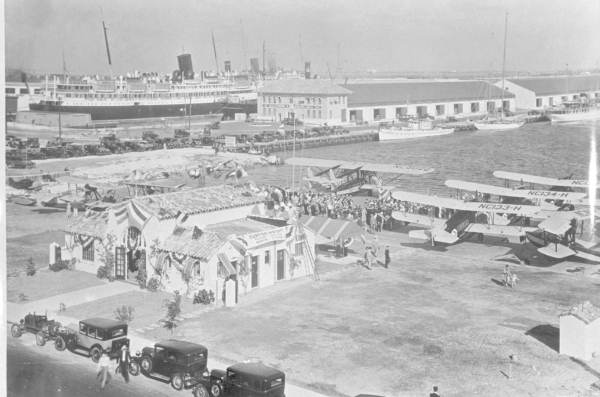
Pappy Chalk initially sold tickets from his “office” – a chair and umbrella on Miami Beach. The reservations line was a crank telephone nailed to a pole and the terminal was the dock at the Royal Palm Hotel. Chalk did all the flying himself and hired staff at Bimini to carry passengers piggyback to the shore. By now, the United States had gone dry in the grips of the prohibition and Chalk’s passengers included rumrunners and lawmen.
90 Years of Chalk’s on Historic Wings
Chalk’s found itself frequently operating with small profits and had to find creative ways to supplement its income. For example, during the years of prohibition in the USA, Chalk’s quietly become the premiere smuggling operation for illegal alcohol imports from the Bahamas to Miami. Even if the authorities found out about it, it seemed that Chalk’s was able to continue flying — at considerable profits, even if under the table.
Around the same time, the shipping channel between Miami and Fisher Island was deepened and the sand and debris dredged up was left in a landfill about two miles east of Miami. The resulting man-made island, originally known as Causeway Island, was deeded to Miami, with the restriction that it could only be used for public or municipal purposes. It was renamed Watson Island (after the then mayor of Miami).
In 1926, Chalk moved his operations to Watson Island, establishing a sea-plane base which is still in use as Miami Seaplane Base (X44). The water runway is 15,000 feet long and oriented NW/SE. I’m amused that the charts specify Elevation Above Mean Sea Level as zero.
The airline continued to do well after the Prohibition ended in 1933, ferrying wealthy customers to the Bahamas but also becoming the airline of choice for connecting the residents of Bimini to Florida. Chalk’s Flying Service became famous: Ernest Hemingway, Errol Flynn, Ava Gardner, Judy Garland and Howard Hughes were among his regular clientele.
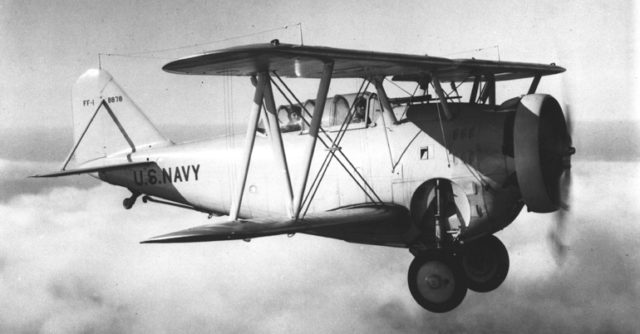
The US entered the war in 1941. The Grumman Aircraft Engineering Corporation had been supplying aircraft to the US Navy since 1930, when they developed the Grumman FF-1, a bi-plane fighter aircraft.
During the war, Grumman was probably best known for the F4F Wildcat and the F6F Hellcat, Navy fighter aircraft. But they also started developing amphibious aircraft: the Grumman J2F Duck biplane amphibian was in service with the US Navy from 1934, followed by the Grumman G-21 Goose and the Grumman G-44 Widgeon, which was also popular with the British Royal Navy’s Fleet Air Arm.
I have to admit, duck and goose and mallard were all clear to me but I had no idea what a widgeon was. In case you are also wondering, Wikipedia says that they are ‘dabbling ducks’ closely related to the gadwall and the falcated duck.
In any event, after the war came to a close, Grumman Aircraft wanted to expand their amphibious line for commercial use. They developed the Grumman Mallard, which had the same twin engines and high wings with underwing floats, but the new flying boat also sported a tricycle gear, a two-step hull and wingtip fuel tanks. The Grumman Mallard could carry two pilots and ten passengers and was designed for harbour-based city-to-city hops.
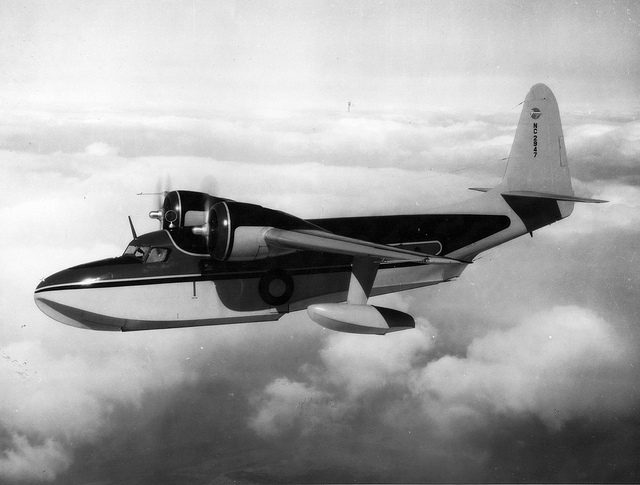
One of the (many) interesting aspects of the Grumman Mallard is that the design is based on what’s called a ‘wet wing’. Instead of fuel tanks in the wing, the fuel is stored in sealed off portions of the wing structure. This design saves on weight and allows more fuel to be carried for any given wing size. The joints around the tank seams are sealed to keep the wing box from leaking fuel.
Another aspect of the Mallard which was new to me is that the Mallard has a maximum zero fuel weight (MZFW).
The zero fuel weight (ZFW) is straight-forward: the total weight of the aircraft and all its contents, not including the useable fuel on board. So if the aircraft weight is 10,000 pounds and the weight of the fuel on board is 1,000 pounds, then the ZFW is 9,000 pounds. After 100 pounds of fuel has been used, the total weight has dropped to 9,900 pounds, where the weight of the remaining useable fuel is now 900 pounds. However, the zero fuel weight remains the same at 9,000 pounds. The point is that the total weight of the aircraft reduces but the zero fuel weight remains constant (although Wikipedia has just reminded me that obviously, if some part of the load is jettisoned in flight, the zero fuel weight can change in flight).
The maximum zero fuel weight (MZFW) is an airworthiness requirement: the maximum weight allowed before useable fuel is loaded.
Rather than using a simple weight calculation for the maximum take-off weight, the Grumman (and other large aircraft with cantilever wings) specifies a maximum zero fuel weight in order to optimise the maximum take-off weight without overloading the fuselage.
This has to do with where the fuel is carried in the wings. Lift on the wings (and the weight of the fuselage) bends the wing tips upwards and the wing roots downwards. However, the weight of the fuel in the wings bend the wing tips downwards, which can provide relief to the bending effect on the wing. So effectively, the capacity for extra weight in the wings is greater than the capacity for extra weight in the fuselage.
Grumman built 59 Mallards between 1946 and 1951. Most were purchased for corporate use but a few small air carriers used it as intended, including Chalk’s Flying Service. Initially, Pappy Chalk purchased a five-passenger Widgeon and a nine-passenger Goose; soon after, he purchased the first of several Mallards.
This Air & Space article on Chalk’s Ocean Airways describes flying in a Chalk’s Mallard.
To a passenger standing at its threshold, the Mallard seems more like an airplane than a boat. But when one steps into the craft, that step is down. So is the next one. Compared with the design of similar-sized landplanes, the door of the Mallard is set higher in the hull to keep out the water, and both the captain and the first officer sit at a higher level in order to see over the bow. With those first steps, plus the scent of salt air, the airplane’s second nature becomes apparent.
The Mallard’s interior reflects the middle years of powered flight—the cabin walls are painted, rather than covered with fabric, and you can count the rivet heads—but the seats are comfortable. Seating is catch as catch can. There’s no door to the cockpit, just an archway in the bulkhead, so you can look up at the pilot and first officer.
Now, not directly related (yet) but worth mentioning is that at the same time, aviation had shifted from a curiosity without much practical use to an industry. The demand for larger loads and better range was increasing every year. In 1956, the president of Pratt & Whitney Canada gave his his engineering manager 100,000 Canadian dollars to develop a turboprop engine to replace piston engines. The first engine was powered up and run successfully four years later, in February 1960, and first flew on a Beech 18 aircraft on the 30th of May 1961 at de Havilland Canada’s facility in Ontario. Full-scale production started in 1963.
Also in 1963, Grumman released a customer service bulletin about the maintenance and care of the Mallards. The wet wings were prone to fuel leaks as the fuel-tight seams began to open, a result of the normal flexing of the wing over time. They also were realising (25 years before Aloha Airlines flight 243) of the corrosive effects of salt water. Customer Service bulletin No 89, released in May 1963, described corrosion as the “greatest maintenance problem” for watercraft. The bulletin stated that Mallards operating in a salt-water environment might suffer corrosion in the lower skin of the wings in the fuel tank areas. Symptoms to watch for included “chronic leakage of fuel, looseness of sealant in the tanks, and/or blisters, swelling, or visible corrosion in the skin in the tank areas”.
In 1966, on his 85th birthday, Pappy Chalk made his final flight and sold his airline to a friend. By then he had 17,000 hours. Chalk’s Flying Service operated four Gooses and three Mallards and was fully staffed with pilots, maintenance and sales personnel.
Around this same time, Frakes Aviation was founded, an aviation business focused on converting aircraft. They purchased the rights to the Grumman Mallard and began replacing the piston engines with Pratt & Whitney Canada PT6 turboprops and upgrading the cabin to hold 17 passengers. The result became known at the Turbo Mallard and the modifications almost doubled the aircraft’s range as well as making it much more fuel efficient. Chalk’s Flying Service immediately saw the potential and started having their fleet of Grumman Mallards, by then eight aircraft, converted to the Turbo Mallard one by one.
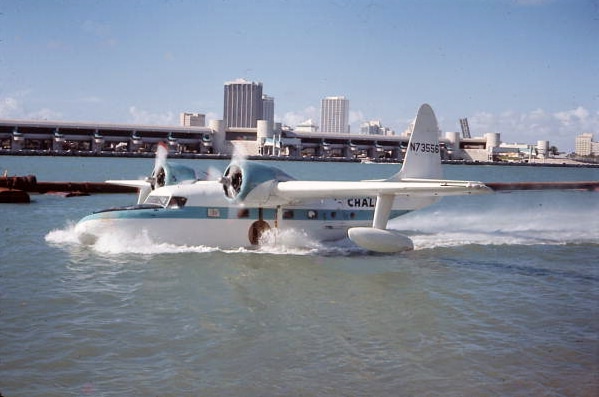
I cannot afford another diversion but it pains me not to mention that one of the Mallards was hijacked in 1972, when two men forced their way on board, wounding the pilot, a mechanic and a bystander, and flew to Cuba. The men were never caught and it’s said that from then on, no Chalk’s aircraft was ever fuelled sufficiently to reach Cuba.
Also, I want to mention that Pappy Chalk continued coming into the office every day until he retired in 1975, during which time the airline was sold again, this time to Resorts International. Employees at the time said he would come with food for the birds and food for the staff and regale customers with stories of how the airline got started. He died in 1977 and I wondered if he’d been ill when he retired. But no, it turns out that he fell out of a tree in front of his house while he was pruning it.
The airline changed hands many times and was, at one point, owned by Donald Trump, who reduced the amphibious fleet to four or five Mallards (of which all but one were Turbos). At the same time, Chalk’s had become a symbol of Miami Beach. The television show Miami Vice featured a Chalk’s seaplane in its opening credit. Chalks seaplanes also appear in the music video for George Michael’s Careless Whisper and in one of the final scenes of Silence of the Lambs.
The next owner, Merv Griffin, attempted to get rid of the seaplanes all together and only offer flights directly to his resort in the Bahamas using the local runway but, apparently, the Bahamian government refused. Merv Griffin sold it in 1991, by which time most of Chalk’s destinations could be reached by land-based planes.
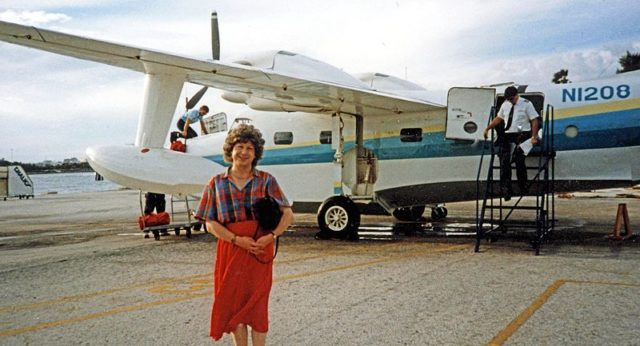
By 1999, the airline had gone through a series of owners and operators and the name was changed to Chalk’s Ocean Airways. By now, the Mallards were around 50 years old and Chalk’s Airline was the primary operator. Eighty years after Pappy Chalk founded the airline, a pilot told Air & Space magazine why she loved working there.
“It’s the closest thing you can get commercially to World War II flying—much more strenuous than most pilot jobs because of the change of the tides and the wind and the boats and the jet skis. It’s hands-on, no autopilot, with hop-skip-and-jump, 20-minute turns, and all-day-long days. But then they give you a lot of days off. It’s a wonderful job.”
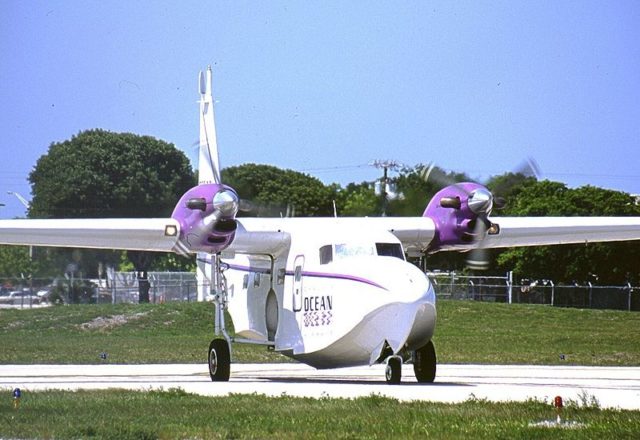
Chalk’s Ocean Airways was proud of the fact that they were the longest continuously running airline and also that they’d operated all this time without a single passenger fatality. However, there had been an accident in 1994, when one of the Turbo Mallard’s crashed on take off, killing both pilots.
The NTSB report is somewhat confusing. The Turbo Mallard (officially a Grumman G-73-T) arrived at Key West Harbor in Florida with 13 passengers on board. After the passengers were disembarked, the flight crew planned to fly to Key West Airport for refuelling. Shortly after lift-off, something went terribly wrong.
Witnesses stated they observed the seaplane take off from the water in the harbor area, and as the airplane climbed to about 100 feet the airplane pitched up, rolled left and crashed nose down in a left roll. The seaplane came to rest on the bottom of the harbor in about 30 feet of water.
The aircraft wreckage was examined where it fell, in about 30 feet of water in the harbour. The hull had been crushed and both wings damaged, with the propellers showing signs of curling and twisting. The flight controls and the aerodynamic surfaces showed fractures and failures consistent with overload. The bilge pump switch was in the off position, i.e. not pumping water out of the bilge.
The Mallard didn’t have a flight data recorder but it did have a cockpit voice recorder. The checklists for start, run-up and take off were only partially completed and, most importantly, the call out for bilge pumps was not recorded as a part of the before-take off checklists. As the aircraft lifted off, the first officer, who was pilot flying, complained about the nose pitching up and the captain stated that they might have a lot of water in the tail. The two pilots struggled to regain control of the aircraft until the sound of the impact with the water. The pilots’ cause of death was determined as salt water drowning.
The National Transporation Safety Board determines the probable cause(s) of this accident to be:
Failure of the pilot-in-command to assure the bilges were adequately pumped free of water (adequately preflighted), which resulted in the aft center of gravity limit to be exceeded, and failure of the aircrew to follow the checklist. A factor related to the accident was the water leak.
I’m sure you are all, like me, wondering what water leak. However, there’s no mention of a water leak in the report other than in the findings (“F: Fluid, water – leak”) and the docket is not available online. I’m so bugged by this, I’ve emailed the NTSB to ask if they can shed any light on the subject although I am not really expecting a response.
The airline shut down in 2007. However, I’ve already gone on long enough; that will have to wait for another day.
Edit: The next post is now here.








Always interesting.
Sylvia has explained what “zero fuel weight” means, as well as maximum zero fuel weight (MZFW).
All correct (of course), but perhaps the explanation is getting lost in between the rest of the article. So, for those who want it again:
Maximum Zero Fuel Weight (MZFW) is a certification requirement.
Let’s assume that a particular aircraft has a maximum take-off weight of 10.000 kg
Assume that the empty weight (no cargo or passengers) is 3.000 kg
Assume the tanks can hold 3.000, that would leave for cargo 4.000 with full tanks
BUT:
Assume the MZFW is 8.000.
Assume we uplift 1.000 kg fuel and load 6.000 kg of cargo:
Assuming there are no take-off or landing weight restrictions, we would be within the maximum allowable take-off weight of 10.000 kg: Aircraft 3000, cargo 6000, fuel 1000.
BUT: the ACTUAL zero fuel weight would be 9000 kg.
We would be OK reducing the cargo by 1000 and uplifting another 1000 kg of fuel. The total, actual take-off weight of our imaginary aircraft in both cases would be the exact same.
As Sylvia explained: It has to do with the stress limits (bending) on the wings.Exceeding it can (probably will) cause metal fatigue in the wing spars
Which is where I started, funnily enough (looking at the crash in Daytona).
“The leak,” which may sound like a mysterious fact left out of the NTSB report, is just a fact of life when flying seaplanes. I imagine that after interviewing pilots from the company, it probably did not occur to the NTSB investigators to mention it.
The bottom line is, all seaplanes that are not made of composites leak. Especially flying boats that are nearly sixty years old. The entire reason that they had bilge pumps was because some of those airplanes leaked like a sieve. The pilots in Key West left the aircraft moored for an hour before takeoff. That is plenty of time for a very large amount of water to seep in through the seams in the bottom.
No extra ‘leak’ needed. Just day to day ops. They just didn’t check the bilge before they left.
Ah hah! Thank you, that makes sense.
I agree – almost anything in the water leaks after some use, and as stated these were old enough to leak ALOT.
I’m surprised that they had manual bilge pumps and didn’t have an automatic one; I know that water alarms and automatic pumps were available then. I was more concerned about the partial checklists referenced above and wonder if they were lucky to not have a more serious accident.
Everyone dead (no passengers, just two crew aboard), about as serious as it gets. That being said, the checklist being read aloud wouldn’t have stopped this accident. Just because the checklist wasn’t read aloud (which is all the report really tells us) does not mean that it wasn’t completed. I’m not advocating for any deviation from standard operations here… however, knowing the aircraft and the checklists, they would have found it impossible to take off if they had not completed the last item on the appropriate checklist. I find it much more likely that they simply completed them silently, which would definitely be lazy but not necessarily unsafe.
All good points. However, the NTSB did conclude that they had skipped the pre-flight pumping, so I presume there was enough evidence to show this beyond the lack of reading out the checklist.
I’m not much the Internet and I’m sure I’m putting the comment in at the wrong place nobody may ever see it, I flew with Chalks as an FO On the turbo Mallard and under Dash-7. I can’t exactly remember When, But one of my captains was Arthur Campbell and another was rick Arena both great pilots
I was an electronics tech for a couple of decades, and I know that simple monitoring systems that weigh very little could be installed in aircraft to monitor the condition of every switch, movable surface, and sensor in the plane, as is being done in automobiles now. Additional lightweight sensors to detect anything measurable could be added throughout the aircraft, and a lightweight circuit board with embedded code could easily be made to report anything problematic to the pilot(s). These _could_ be made very inexpensively, and they have a huge potential for saving lives and aircraft. Are these sorts of monitoring systems being installed in aircraft now?
Such instrumentation would be relatively inexpensive to build, install, and test, even with the requirement for sensors robust enough to withstand the environment. The expensive component would be the certification.
You can’t just bolt anything you please to your aircraft, especially where you might come to rely on it, and then put yourself before the public as an air transport business. The design of everything that might impact the safety of your passengers must be tested and inspected by many different experts with many different skill sets, in the hope that any silly flaws will be caught by somebody.
This is an expensive process, required for each new component design for each aircraft model. For a type that is no longer being manufactured, with few hulls still in service, there is not enough market to amortize the certification costs.
This is a good explanation, thanks.
Like the Wheatstone Bridge in the bilge sniffer on boats. No sailor worth his salt would attempt to start his engines without opening bilge hatches and running the blowers ’til the bilge sniffer reach an acceptable level.
I never flew seaplanes, just once as a passenger.
It must have been in 1966 in Nigeria.
At the time, I was working as flight operations dispatcher for a company called Pan African Airlines (Nigeria) ltd, based at Ikeja, Lagos Airport.
They operated a few amphibious floatplanes,I believe they were Cessna 185. The company also maintained a few seaplanes for one or two oil exploration companies, like Howard Hughes’ Global Marine. They were Westland Widgeons, similar in shape but a bit smaller than the Mallard. Global Marine’s Widgeon was called “Miss Glomar Ette”.
The pilot of one of them constantly complained about a mysterious leak. At one of their destinations it was difficult apparently to bring the aircraft on land, so it had to be moored until ready to go. I do not think it was equipped with an electrical bilge pump, water had to be pumped out by hand. Each time after having been anchored for a few hours, the pilot had to pump water out of the bilges. Yet, on the ramp (like the floatplanes, it was amphibious), no water came out.
The pilot and the chief engineer decided to sort this out once and for all by flying to the Lagos Lagoon, land there and wait and see where water entered.
For the purpose, they removed floor boards and anything that could be in the way when investigating.
I had a few hours to spare and went along for the ride.
We landed in the lagoon, the engineer and the pilot peered into the bottom of the aircraft. Eventually the cause was found: A rivet from the skin under the water line had failed. It was not visible, but the pressure from the water pushed the skin inwards, letting water in.
On dry land, the opposite happened. Water in the bilge pushed downwards, closing the leak.
It was time to go back.
The Widgeon had radial engines, and they would not start.
Battery power was getting low and when the floor boards were removed, the pilot had accidentally left the bilge pump behind.
A radio call to Lagos Airport went unanswered, we were not in range.
We did have life jackets, but the lagoon was infested with crocodiles. Or so we had been told.
We were slowly sinking when, on the last gasp of the batteries, one engine caught. The other would not. The pilot opened the live engine and we circled at speed around in the large lagoon. At least, we were no longer sinking. It must have been the right engine that was running because we going around anti-clockwise.
I cannot remember what was used, but there must have been something like an empty tin on board because I remember the engineer frantically scooping water out.
But at long last the port engine came to life. A long run across the water, we nearly rammed a dug-out canoe. Perhaps it was someone who came to see if he could help, perhaps he was only curious why we were playing not-so-merry go-around. But the pilot was desperate to get it “on the step” and could not have avoided the canoe. Fortunately, we stayed clear, the airplane lifted off. Very slowly climbing, too heavy perhaps, or to avoid the risk of water flowing to the rear I suppose.
On the parking the water was pumped out, rivet replaced, joint sealed. We had survived the adventure.
But I must admit that I never really had the desire to get a seaplane rating, even though I love boats.
Great story!
I agree with Old Salt!
I flew on Chalks a few times to the Bahamas. It was fun but after flight 101 in Miami in Dec 2005 if I remember correctly, it was over. I’m a pilot and live in South Florida so the news traveled quickly.
There wasn’t enough room to go over that in this post but it’s coming soon, I promise :)
That Mallard G 73 was formerly Texaco 76 based in Houma, LA. For some reason it was not liked by the flight crews. Texaco had three other Mallards based in Houma: Texaco 61, Texaco 64, and Texaco 90.
Sylvia:
I was the Grumman Mallard Owners’ Association representative in the NTSB investigation of the Chalk’s 2005 Mallard accident. If you are planning to write about this you are welcome to contact me for details and/or verification.
Thank you! I appreciate the offer although I’m not sure I will be picking this one up again.
Chalk’s International Airline seaplane crashed shortly after takeoff from Key West harbor in March 1994 mainly because the pilots failed to pump the aircraft’s bilges free of water.
That was the finding of the National Transportation Safety Board in a probable cause statement obtained on Tuesday. The two pilots, the only occupants, were killed.
The plane’s hull had developed a leak, weighing down the tail with water, safety board records show. Because the tail was heavy, the twin-engine Grumman Mallard’s center of gravity was upset, the board’s accident report said.
The 17-seat plane pitched up abruptly shortly after takeoff, rolled to the left and crashed nose down. It sank in about 30 feet of water.
Contributing to the crash was the pilot’s failure to follow a checklist before takeoff, which calls for the bilge pumps to routinely be turned on before each flight, the board said.
Also, the board said the pilots should have visually checked the bilges during their preflight inspection because a seaplane, like any boat, will take on water.
Chalk’s, which at 76 years old is the world’s longest continually running airline, is based at Fort Lauderdale-Hollywood International Airport. The crash was the company’s only fatal accident.
Capt. John Alberto, 31, of Wellington in Palm Beach County, and First Officer Alan Turner, 25, of Pompano Beach, had just dropped off 13 passengers at Christmas Tree Island, about a mile from downtown Key West.
They were planning to fly to nearby Key West International Airport to refuel, then pick up more passengers and return to Miami.
The plane’s cockpit voice recorder captured the pilots’ alarm at seeing the nose pitch up sharply after takeoff, about 11:30 a.m.
” … Might have a lot of water in the tail,” said Alberto, who at the time was the airline’s chief pilot.’ “A lot of water,” Turner said.
On December 19, 2005, about 1439 eastern standard time, a Grumman Turbo Mallard (G-73T) amphibious airplane, N2969, operated by Flying Boat, Inc., doing business as Chalk’s Ocean Airways flight 101, crashed into a shipping channel adjacent to the Port of Miami, Florida, shortly after takeoff from the Miami Seaplane Base. Flight 101 was a regularly scheduled passenger flight to Bimini, Bahamas, with 2 flight crewmembers and 18 passengers on board. The airplane’s right wing separated during flight. All 20 people aboard the airplane were killed, and the airplane was destroyed by impact forces. Flight 101 was operating under the provisions of 14 Code of Federal Regulations Part 121 on a visual flight rules flight plan. Visual meteorological conditions prevailed at the time of the accident.
Probable cause: The in-flight failure and separation of the right wing during normal flight, which resulted from:
1) The failure of the Chalk’s Ocean Airways maintenance program to identify and properly repair fatigue cracks in the right wing and
2) The failure of the Federal Aviation Administration (FAA) to detect and correct deficiencies in the company’s maintenance program.
I flew CF-UOT Turbo Mallard for Nordair and Canadair in Montreal, a couple of thousand hours there. (Along with B-737 and CL-215)
I am a retired Aviation Technician who worked on Mallard CF-UOT at Nordair in Montreal in the 1970’s. I recall one engineer expressly telling us to pay attention in the rear fuselage for popped rivets and leaking seams. I personally never found any. However, a few years later, I worked at Canadair on the CL-215. My very first job there was to fly out to Lake St. Jean, remove the floor panels, and armed with a flashlight, mark any leaks in the hull with a red grease pencil taped to a dowel!!
Pappy Chalk was a longtime friend of my grandfather, boatbuilder and racer H. Paul Prigg. Back in the early 1940’s, my grandfather persuaded Pappy to teach two of his daughters, Jane and Dorothy to fly his seaplane. My mom, Jane, now passed away, had fond memories of Pappy.